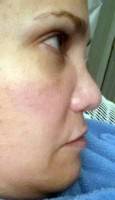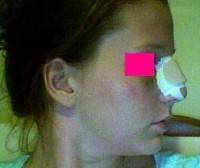Boxy tip rhinoplasty usually addresses the lower third of the nose and may deal with abnormalities of the tip such as boxiness, pointedness, or an irregular shape. Sometimes a tip rhinoplasty can be done alone but most times the upper two thirds of the nose will have to be adjusted to fit the new tip. (Paul Vitenas, Jr., MD, Houston Plastic Surgeon)
The “tip” of the nose generally refers to the lower third or so of the nose. A “boxy tip rhinoplasty” implies that only the tip needs improvement, and that the bridge and width of the nose may be left as-is – basically performing less than a “complete” rhinoplasty. This is similar to repainting the front half of a car if the back half looks pretty good already. In my practice, boxy tip rhinoplasty is rare – the difference between refining the tip alone or the tip plus upper two thirds of the nose is negligible.
Further, even if the bridge and upper two thirds of the nose seem OK before the boxy tip rhinoplasty, they are sometimes less than ideal once the tip is optimized. In our car analogy, it would be like having a perfect coat of paint on the front half, and the “pretty good” back half now starts looking out of place.
I agree with the other posters – the tip of the nose is where the art lies! Rhinoplasty is one of my favorite operations for that reason alone. (Laxmeesh Mike Nayak, MD, Saint Louis Facial Plastic Surgeon)
The tip is just one of the anatomical features of the nose. Its shape and position is determined by the tip cartilages (the lower lateral cartilages). Some of the possibilities for change include: elevating the tip (shortening the nose), lowering the tip (lenghtening the nose), narrowing the tip, chaging the tip shape, correcting contour irregularities, making the tip more symmetrical, and making the tip less pinched (often done in revision cases).
In my opinion, the ultimate goal for tip surgery should be to create a smooth, soft triangular shape that is in balance with the upper 2/3 of the nose.
There are dozens of techniques which can be used. Just be wary of over-reduction as problems with nasal breathing or contour may result. (David W. Kim, MD, Bay Area Facial Plastic Surgeon)
Boxy tip rhinoplasty is a location-specific term for Rhinoplasty
When one talks about a “tip” rhinoplasty, it is usually a rhinoplasty that creates shape changes of just the tip. In other words, if the patient is happy with their appearance of the dorsum (bridge) and upper 2/3rds of their nose, but hates the bulbosity of their tip, they may only need modification of the tip. In the end, rhinoplasty is rhinoplasty. Boxy tip rhinoplasty by no means makes the surgery easier since it is often the tip that is the most challenging to modify.
It is also the region that patients complain about the most when they come into my office seeking revision surgery from procedures done elsewhere. It takes a through understanding of tip dynamics and anatomy to create nice long-lasting rhinoplasty results. (Michael M. Kim, MD, Portland Facial Plastic Surgeon)
What Is boxy tip rhinoplasty?
Boxy tip rhinoplasty is a rhinoplasty procedure that is limited to the tip of the nose. A complete rhinoplasty addresses the entire nose. Some noses are visually pleasing except for tip and in these cases, surgery can be limited to the tip. Surgery of the nasal tip is generally regarded by rhinoplasty surgeons as the most challenging part of rhinoplasty which requires the most finesse.
The surgery may involve just placing sutures to change the shape of the tip cartilages or it may involve complicated maneuvers to change the tip position and or cartilage grafting procedures. (Jonathan Pontell, MD, FACS, Philadelphia Facial Plastic Surgeon)
Boxy tip rhinoplasty – insurance coverage
About 60% of our patients having rhinoplasty also have a procedure to improve their nasal breathing. We separate any surgery covered by insurance (i.e. septoplasty) from cosmetic work by using the the term “boxy tip rhinoplasty.” In reality, it is uncommon to just modify the tip of the nose (except revision rhinoplasty) because the balance of the nose would be affected if we change the tip of the nose and not the nasal bridge. (Pramit Malhotra, MD, Ann Arbor Plastic Surgeon)


